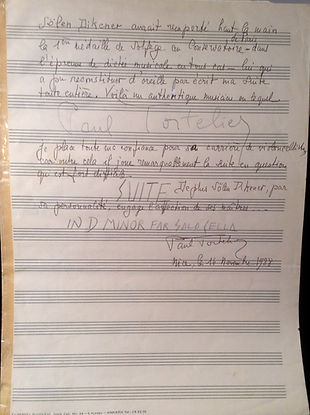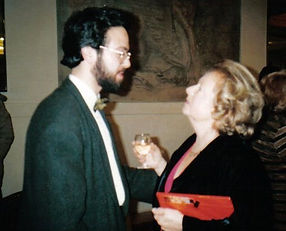Ş Ő L E N D İ K E N E R | c e l l i s t / c o m p o s e r
“Here is an authentic musician in whom I place all my confidence for his career as a cellist and moreover Dikener, by his personality engages the affection of his masters”
Paul Tortelier
When Paul Tortelier performed a recital at the International Istanbul Music Festival in 1981, it marked a dramatic turning point in my artistic life. I remembered vividly that I was walking for hours on the streets of the mega city feeling lost with the impact of his performance, but also have “found” compassion!
I knew that I had found my artistic direction as a cellist; however puzzled about reaching one of the emperors of the cello players. As I further developed my personal taste of Tortelier’s performances through recordings – very limited for me in those days - one particular recording struck me the most - the Suite for Solo Cello in D minor by “Mâitre” himself. Since I did not have any resources of finding the sheet music of this magnetic work, I decided to write it down while listening to it (nearly hundred times). And I eventually learned to play it. In my despair of attaining a connection with Tortelier, the magic happened one day when I spoke to Mrs. Verda Erman, one of the leading pianists from modern Turkey. Upon explaining her my yearning to study with Tortelier, she replied me with an answer that I was expecting. Evidently she was in the same music theory class with Yan Pascal Tortelier at Paris Conservatoire and that she would be willing to reach him out in order to deliver my recording and personal letter to his father.
In meantime, I had accepted a scholarship, which enabled me to study abroad in Vienna, Austria. While taking advantage of this opportunity, I was working with Professor Tobias Kühne at the Hochschule fur Musik over a year. During late fall of 1987 I received a letter from Paul and Maud Tortelier telling to me that they listened to my recording and
would be happy to teach me cello! Additionally, they also suggested supplementary cello studies with their assistant German cellist Frieder Lenz, super soloist of the Nice Philharmonic. What better news one could wish for - having three teachers at the same time! Following by a cordial farewell conversation with Prof. Kuhne I left Vienna in a snowy early December day, to fulfill my dreams for in Nice, France.
My new musical life began immediately as I was invited to perform in a cello ensemble of 35 cellists, conducted by Tortelier himself. The players were from the cello sections of Nice, Cannes and Monte Carlo Philharmonic Orchestras. In this long session, we recorded “Le Grand Drapeau” by Tortelier, who submitted a copy to Slava Rostropovich for his consideration of the work to be performed at the World Cello Congress in Washington, DC in coming year. After the recording, everyone was invited to Torteliers’ beautiful home at Mont Boron to celebrate together. There I got the chance to meet many artists including American cellist Lane Anderson (principal cellist, Monte Carlo Phil).
During my first six months, I had to remain patient while adjusting my technique to Tortelier style (including using his famous bend endpin) and all I had to study was lots of open string, scale and etudes. Once for my lesson with “Mâitre,” I prepared the Rococo Variations. Just as I finished the theme, his first comment was that I should not be playing this theme “so fast as the rest of the world do”. After we worked on the entire work for two hours, I asked if he had more time for me to play one more piece, which I was considering as my “encore” following Rococo Variations at concert. This was the Allemande from the Suite for Solo Cello by Tortelier. There was a long silence after I finished the movement as Tortelier finally put his hand on my shoulder and said: “have a look at the pictures of these great composers on my wall” (there were portraits of Bach, Beethoven, Brahms etc.) and he continued “when I play their works I act like the composer myself and today when you played my work, Allemande you were Tortelier yourself.” I believe this was the most memorable moment of my life! Afterwards I showed him my manuscript (my version of the entire suite written down as listened to it from the recording) for his evaluation. He sat down at his table and wrote the following dedication on the cover page of the manuscript:
“Solen Dikener received the first medal of solfege at the conservatory - in the ordeal of musical dictation in any case - and by ear he was able to reconstruct my entire suite. Here is an authentic musician in whom I place my confidence in his career as a cellist because he plays this difficult piece with a remarkable result. More so Solen Dikener, by his personality, encourages the affection of his master"
Paul Tortelier, Nice 16 November 1989
My lessons with Maud Martin-Tortelier (la Madame) were just as exuberant. She became an inspiration for me that lasted for a lifetime. I was having lessons every other week with Maud and on one occasion during late spring, I was working on the C major cello concerto by Haydn with her and probably I must have been playing pretty monotonous, not feeling the joy necessary to perform this piece. She interrupted me in the middle of the lesson and told me that we should now stop the lesson immediately because it would be beneficial for me to go beach and swim instead of continuing the lesson. She kindly rescheduled our lesson to next day. Well, as I made it to Mediterranean shore the water was quite cold (was early May), but since I was instructed to swim by my teacher, I sure did it and returned home feeling chilly. After I ate dinner, I start practicing the Haydn concerto, now curiously sounding more promising. The next day my playing at my rescheduled lesson was completely transformed from “boring” to “inspiring”; Madame was happy. In general I was invited to stay over for dinner with them after my lessons, sitting at the same table with Paul, Maud and also Maria; the most genuine and modest people despite their grand artistic legacies.
Maria de la Pau, their pianist daughter was also living with them that year. While I was playing in my lessons, she would jump to the piano and start playing the accompaniment parts of the pieces, a repertoire she knew by heart while performing with her parents. Maria and I spent lots of time together at her parents Mont Boron residence in Nice while they were away on concert tours. I would drive the Torteliers in their small Renault – both cellos on front passenger seat, scrolls down – to the airport and pick them up on their return. But before they left for every tour, we were invited to attend the dress rehearsal, which was usually the last evening before their departure. And furthermore we were required to critique – not only positive – that they would consider seriously. This marks one of the rare moments that I remember being respected this much, not by ordinary people but by glorious saints of music. While staying at the Mont Boron residence in Nice, I was exposed to entire sheet music and recording library of Torteliers. Usually his music was marked with multiple colors, each color indicating different bowing and fingerings, belonging to diverse eras of his career. Upon his return from one of his concert tour “Mâitre” found me studying on of his scores wide open in front of me in his office. He noticed that I was copying his markings into my score, and said to following to me: “do not copy what I have done, you should find your own voice.” And he took his score away.
As I was attending lessons Maud and Paul, my main weekly cello drill took place at Lenz residence, just down the alley from Torteliers in Mont Boron. I met Frieder and Maria, his pianist wife through letters while communicating with Mâitre prior to coming to Nice, France. They moved there, to be closer to him and also earning his life as an orchestra player. Upon my arrival, they hosted me for two weeks in their house, a very generous gesture. They eventually became a family for me. In return to their generosity, I offered to babysit their young children Lukas and Florentine. My lessons with Frieder were eye opening! He introduced me to advanced bow techniques (Sevcik) and practice methods in which I learned to “dissect” a musical work to best learn its technical needs in order to better serve my musicality. We finally were able to reconnect in person after decades when I invited Frieder to teach at Datca Summer Music Academy in Turkey in 2007.
Those three years I spent between 1987-1990 were golden years of my artistic education. It was not just about meeting and knowing a grand master of cello, but following one’s own path, a pursued dream that became a reality. Upon the end of my four-year scholarship, I left Nice during late summer. Indeed I was unaware that the next time I was going to meet Maud and Frieder was going to be in Paris, at Radio France building when we all had to meet for the first anniversary of Paul’s passing away.
As this was pre-Internet age, we sent each other letters or called one another. By mid-December, my home phone in Ankara rang and I heard a sad voice talking, it was Frieder. This was unusual. He wanted to inform that the “Mâitre” died yesterday while teaching a master class near Paris. We all knew that his doctors were worried about his intensive schedule and asked him reduce travel, especially for overseas. He had just promised Maud, the love of his life, about slowing down his career; however the destiny has pushed his legacy for giving his last breath on stage. After all, this man was known to sleep only five hours a day, did daily workouts and was careful for his health. No one was expecting this untimely passing and devastated with the news including my mother who was one of his big fan. One day driving on Avenue Saint Germain of Mont Boron, my mother was in the car with me while we saw Paul jogging up the hill. When he saw us in the car, he approached to salute us as I introduced him my violinist mother; I remember vividly that he gently smiled and shook her hand greeting us, then left to finish his exercise. While the “Don Quixote” of all cellists was disappearing in distance with his fluffy white hair and thin silhouette, my heart warmed up as usual with endless joy and pride; something I still keep up fresh to this date.
Cordially,
Şölen Dikener


